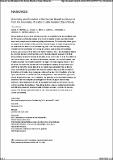Por favor, use este identificador para citar o enlazar a este item:
http://hdl.handle.net/10261/203726COMPARTIR / EXPORTAR:
 SHARE
BASE SHARE
BASE
|
|
| Visualizar otros formatos: MARC | Dublin Core | RDF | ORE | MODS | METS | DIDL | DATACITE | |

| Título: | Geometry and Evolution of the Iberian Massif as Deduced from the Geometry of a Mid-Crustal Seismic Discontinuity |
Autor: | Ayarza, P.; Martínez, A.; Alcalde, Juan CSIC ORCID ; Martí, David CSIC ORCID ; Andrés, Juvenal CSIC ORCID ; Palomeras, Imma; Carbonell, Ramón CSIC ORCID ; Martínez-Catalán, J. R. | Palabras clave: | Earth Processes | Fecha de publicación: | 9-dic-2019 | Resumen: | Normal incidence deep seismic reflection experiments conducted in the Iberian Massif since the 90's show an outstanding change in the seismic signature at upper and lower crustal levels and a conspicuous boundary separating both domains. This mid crustal feature gives us insights on the evolution of this part of the Variscan Orogen. Its depth and geometry can be related with the amount of crustal thickening, later extension and partial melting underwent by the Gondwanan crust during the Variscan collision with peri-Godwanan terranes and Laurussia. To the SW, in the South Portuguese Zone, this discontinuity divides the crust into two layers of similar thickness but featuring opposite vergence reflectivity, which probably represents Variscan deformation. As we move to the N, in the Ossa Morena and Central Iberian zones, the discontinuity becomes shallower, but crustal thickness stays relatively constant. This indicates that either the upper crust was originally thinner or that the whole crust thickened and was later re-equilibrated isostatically through erosion and uplift. To the NW of the Iberian Massif, the Central Iberian and Galicia-Trás-os-Montes zones, both affected by generalized late Variscan crustal melting, show little remnants of this feature or it is rather deep, leaving an extremely thin lower crust. Contrarily, in Central Spain, but still in the Central Iberian Zone, melting seems to have affected the upper crust but has left part of the lower crust unaffected. The geometry of this mid crustal boundary, as observed in the most complete and homogeneous seismic image of all the vertical incidence seismic data acquired in the Iberian Massif up to date and here presented, can help to understand its significance. This striking feature evidences contrasting deformation and different mechanisms to accommodate it at upper and lower crustal levels and may represent the Iberian equivalent of what, in other areas worldwide, has been named as Conrad Discontinuity. | Descripción: | AGU General Meeting 2019, in San Francisco, 9-13 december 2019 | Versión del editor: | https://agu.confex.com/agu/fm19/meetingapp.cgi/Paper/575180 | URI: | http://hdl.handle.net/10261/203726 |
| Aparece en las colecciones: | (Geo3Bcn) Comunicaciones congresos |
Ficheros en este ítem:
| Fichero | Descripción | Tamaño | Formato | |
|---|---|---|---|---|
| Carbonell_AGU_Geometry.pdf | 103,46 kB | Adobe PDF |  Visualizar/Abrir |
CORE Recommender
Page view(s)
111
checked on 24-abr-2024
Download(s)
51
checked on 24-abr-2024
Google ScholarTM
Check
Este item está licenciado bajo una Licencia Creative Commons

